Related Research Articles

Cecil Turtle is a fictional character in the Warner Bros. Looney Tunes and Merrie Melodies series of films. Though he made only three theatrical appearances, Cecil has the unusual distinction in that he is one of the very few characters who were able to outsmart Bugs Bunny, and the only one to do so three times in a row and at the rabbit's own game. Cecil often gives Bugs the taunting nickname of "Speedy" when addressing the rabbit.

Fresh Hare is a Warner Bros. Merrie Melodies cartoon directed by Friz Freleng, written by Michael Maltese, and produced by Leon Schlesinger. It was released to theatres on August 22, 1942.

Hillbilly Hare is a 1950 Warner Bros. Merrie Melodies cartoon directed by Robert McKimson. The short was released on August 12, 1950 and stars Bugs Bunny.
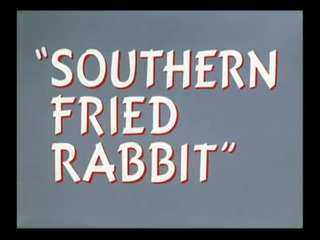
Southern Fried Rabbit is a 1953 Warner Bros. Looney Tunes cartoon directed by Friz Freleng. The cartoon was released on May 2, 1953, and stars Bugs Bunny and Yosemite Sam.

Hare Brush is a 1955 Warner Bros. Merrie Melodies animated short directed by Friz Freleng. The short was released on May 7, 1955, and stars Bugs Bunny and Elmer Fudd.
A Wild Hare is a 1940 American animated comedy short film directed by Tex Avery, produced by Leon Schlesinger, and distributed by Warner Bros. as part of the Merrie Melodies series. The film was released on July 27, 1940, and features Elmer Fudd and Bugs Bunny, the latter making what is considered his first official appearance.

The Heckling Hare is a Merrie Melodies cartoon, released on July 5, 1941, and featuring Bugs Bunny and a dopey dog named Willoughby. The cartoon was directed by Tex Avery, written by Michael Maltese, animated by soon-to-be director Robert McKimson, and with musical direction by Carl W. Stalling. In a style that was becoming typical of the Bugs character, he easily outwitted and tormented his antagonist through the short, his only concern being what to do next to the dog.
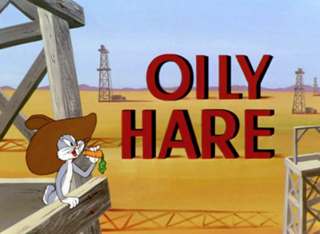
Oily Hare is a 1952 Warner Bros. Merrie Melodies animated short directed by Robert McKimson and written by Tedd Pierce. The short was released on July 26, 1952, and stars Bugs Bunny.

The Old Grey Hare is a 1944 Merrie Melodies cartoon directed by Bob Clampett. The short was released on October 28, 1944, and features Bugs Bunny and Elmer Fudd.

8 Ball Bunny is a Warner Bros. Looney Tunes cartoon directed by Chuck Jones. The short was released on July 8, 1950, and stars Bugs Bunny and Playboy Penguin.

Haredevil Hare is a 1948 Looney Tunes cartoon directed by Chuck Jones. It stars Bugs Bunny and it is the debut for Marvin the Martian — although he is unnamed in this film—along with his Martian dog, K-9. Marvin's nasal voice for this first film is different from the later one he is most known for. This is also the last pre-August 1948 Looney Tunes and Merrie Melodies cartoon whose copyright was sold to Associated Artists Productions.

Roman Legion-Hare is a 1955 Warner Bros. Looney Tunes animated short directed by Friz Freleng. The short was released on November 12, 1955, and stars Bugs Bunny and Yosemite Sam. The title is a play on the words Roman Legionnaire. After being ordered by Emperor Nero to find a victim to be tossed to the lions, Yosemite Sam tries to capture Bugs Bunny.
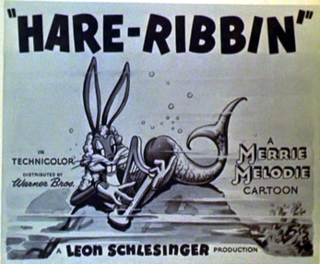
Hare Ribbin' is a 1944 animated short film in the Merrie Melodies series, directed by Robert Clampett and featuring Bugs Bunny. The plot features Bugs' conflict with a red-haired hound dog, whom the rabbit sets out to evade and make a fool of using one-liners, reverse psychology, disguises and other tricks. It was released in theaters by Warner Bros. on June 24, 1944. The title is a pun on "hair ribbon".
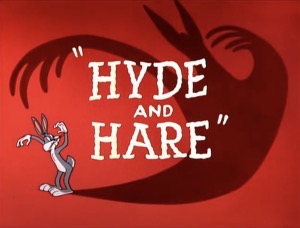
Hyde and Hare is a 1955 Warner Bros. Looney Tunes cartoon, directed by Friz Freleng. The short was released on August 27, 1955, and stars Bugs Bunny. The short is based on Robert Louis Stevenson's 1886 novella Strange Case of Dr Jekyll and Mr Hyde. The cartoon pits Bugs against Dr. Jekyll, who continues to turn into Mr. Hyde. The title is a play on the expression "neither hide nor hair."
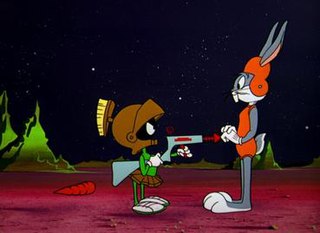
Mad as a Mars Hare is a 1963 Warner Bros. Merrie Melodies cartoon directed by Chuck Jones and Maurice Noble. The short was released on October 19, 1963, and stars Bugs Bunny and Marvin the Martian. The cartoon's title is a play-on-words of the famous phrase to be "mad as a March hare". This is Marvin's final appearance in the Looney Tunes shorts during the Golden Age of American Animation.
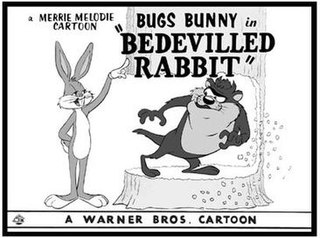
Bedevilled Rabbit is a 1957 Warner Bros. Merrie Melodies short directed by Robert McKimson. The short was released on April 13, 1957, and stars Bugs Bunny. In this cartoon, Bugs is lost in Tasmania, and has to deal with the Tasmanian Devil.

To Hare is Human is a 1956 Warner Bros. Merrie Melodies cartoon directed by Chuck Jones. The short was released on December 15, 1956, and stars Bugs Bunny and Wile E. Coyote. In this film, Wile builds a UNIVAC computer, and grows to rely on its answers.

This Is a Life? is a 1955 Warner Bros. Merrie Melodies animated cartoon directed by Friz Freleng, written by Warren Foster, and produced by Edward Selzer, with music directed by Milt Franklyn. The short was released on July 9, 1955, and stars Bugs Bunny. The voices were performed by Mel Blanc, Arthur Q. Bryan, and June Foray in her first work for Warner Bros. This is one of the few Bugs Bunny cartoons whose title does not contain Bugs, bunny, rabbit/wabbit or hare.

Bill of Hare is a 1962 Warner Bros. Merrie Melodies cartoon directed by Robert McKimson. The short was released on June 9, 1962, and stars Bugs Bunny and the Tasmanian Devil.
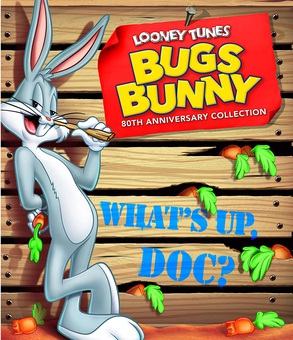
Looney Tunes: Bugs Bunny 80th Anniversary Collection is a Blu-ray Disc box-set released by Warner Bros. Home Entertainment on December 1, 2020. It contains 60 Looney Tunes and Merrie Melodies shorts starring Bugs Bunny and numerous bonus features and supplementary content. The set's packaging includes a slip book, a booklet, and a collectible Bugs Bunny Funko! POP doll.
References
- ↑ Beck, Jerry; Friedwald, Will (1989). Looney Tunes and Merrie Melodies: A Complete Illustrated Guide to the Warner Bros. Cartoons. Henry Holt and Co. p. 287. ISBN 0-8050-0894-2.
- ↑ Lenburg, Jeff (1999). The Encyclopedia of Animated Cartoons. Checkmark Books. pp. 60–62. ISBN 0-8160-3831-7 . Retrieved 6 June 2020.
- ↑ Goldmark, Daniel; Taylor, Yuval, eds. (2002). The Cartoon Music Book. Chicago Review Press. ISBN 9781569764121.
- ↑ The CENSORED Looney Tunes and Merrie Melodies Guide